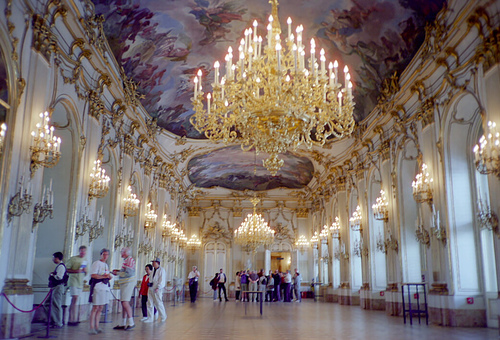We took the optional tour of the Palace this afternoon. It was about a twenty minute drive from the boat.
Formerly the imperial summer residence, Schloss Schönbrunn(Schönbrunn Palace) and its gardens to the south-west of Vienna, near the River Wien, form one of the most important creations of Viennese art in the 18th century.
Despite its apparent unity of style, the complex incorporates various structural changes resulting from its long history. After World War I the palace became a museum; it was restored after damage in World War II.
Remodelling and modernization began in 1743, when the young Empress Maria-Theresa ordered that the building, one of her favourite residences, should be repaired and enlarged to accommodate the imperial household in comfort.
Maria Theresa (1717-1780), archduchess of Austria, Holy Roman Empress, and queen of Hungary and Bohemia, began her rule in 1740. She was the only woman ruler in the 650 year history of the Habsburg dynasty. She was also one of the most successful Habsburg rulers, male or female, while bearing sixteen children between 1738 and 1756. Maria Theresa was married to Francis I, Duke of Lorraine. Maria Theresa was one of the few people in her age who married for love. She loved her husband dearly and passionately. She had 16 children by him, with 11 daughters (ten of whom had the first name "Maria") and five sons.
Her youngest daughter was Maria Antonia, better known under her French name Marie Antoinette, who would be promised in marriage to the later King Louis XVI of France.
Marie Louise who became Napoleon's second wife, bearing him a son, was a great granddaughter of Empress Maria Theresa through her father, and thus a great niece of Marie Antoinette.
It appears there are several correct spellings for the palace name.
The view across the street from the palace.
Looking towards the front of the palace.
Unfortunately you cannot take photos inside. However, I did find some online.
Schoenbrunn Palace site has amazing photos of the interior.
There are some panoramic views of the rooms here and here.



The back of the palace and the gardens.
The Gloriette. A gloriette (from the 12th century French for "little glory") is a building in a garden erected on a site that is elevated with respect to the surroundings. The structural execution and shape can vary greatly, often in the form of a pavilion or tempietto, more or less open on the sides.
The largest and probably most well-known gloriette is in the Schönbrunn Palace Garden in Vienna. Built in 1775 as the last building constructed in the garden according to the plans of Austrian imperial architect Johann Ferdinand Hetzendorf von Hohenberg as a "temple of renown" to serve as both a focal point and a lookout point for the garden, it was used as a dining hall and festival hall as well as a breakfast room for emperor Franz Joseph I.

.JPG)




.JPG)
.JPG)
.JPG)
.JPG)
.JPG)
.JPG)
.JPG)
.JPG)
.JPG)
.JPG)
.JPG)

Thanks for the lovely pictures from Schönbrunn, it looks really lovely.
ReplyDeleteI visited in the late 80's and hope to get back some day to get some new photos.
I hope you keep enjoying your trip.